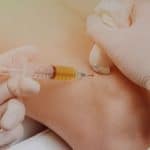Platelet-rich plasma (PRP) injections are increasingly being researched and used as effective treatments for joint pain, arthritis, tendon and ligament injuries, and nerve damage. Patients may ask: “What can I do to make PRP injections work better?”
In my experience, what you do before and after your injection is just as important as the treatment itself. The quality of the PRP, the expertise of the provider, and the steps you take to support your body all matter.
Here are five key steps I recommend to optimize your response to PRP injections:
1. Get High-Quality PRP
Not all PRP is created equal. One of the most important lessons from research is that platelet concentration and total platelet dose matter.
-
Studies suggest the best results occur with a 5–6x baseline platelet concentration or at least 1 billion platelets per milliliter of PRP.¹ ²
-
Different conditions may require different PRP formulations. For example, leukocyte-poor PRP (LP-PRP) often works better for arthritis, while leukocyte-rich PRP (LR-PRP) may be more effective in tendon, ligament, or nerve injuries.³ ⁴
-
The processing method used in the clinic plays a major role in whether PRP reaches these concentrations consistently.
If not being seen at FoRM in Portland, Oregon, I would encourage patients to ask their provider what type of PRP system they use, and whether it can consistently hit these target concentrations. It’s one of the best ways to make sure you’re getting the highest-quality treatment.
2. Exercise — But Modify It After PRP
Exercise plays a powerful role in preparing your body for PRP and supporting recovery afterward.
-
Research shows that regular activity can increase circulating platelets and mobilize stem cells, both of which support tissue healing. High-intensity interval training (HIIT) is specifically effective for this.⁵ ⁶
-
It is important to understand that exercise may be significantly modified and reduced immediately after PRP to allow for proper recovery. Overloading the tissue too soon can interfere with the healing process.
-
A gradual, guided return to activity is essential.
With rare exception, I typically recommend working with our sports chiropractors or physical therapist after PRP. They help patients ease back into activity safely, without compromising the healing process. Even gentle mobility drills should be supervised initially to ensure proper progression.
3. Follow an Inflammation-Modulating Diet
PRP works by triggering a controlled inflammatory response to jumpstart healing. Nutrition helps determine whether that inflammation is healthy and short-lived—or chronic and destructive.
-
A Mediterranean-style diet, emphasizing vegetables, fruits, legumes, whole grains, fish, and olive oil, has been shown to reduce harmful inflammation and support platelet function.⁷
-
Diets high in processed foods, refined sugar, and unhealthy fats promote low-grade inflammation that can interfere with repair.
Your diet is like fuel for recovery. It can either accelerate healing, or it can make inflammation last longer than it should. If you’re investing in PRP, pairing it with the right diet is one of the smartest choices you can make.
4. Use Supplements at the Right Time
Supplements can play a powerful role in supporting PRP, but timing is critical. Some nutrients boost stem cell activity, while others may interfere with platelet function—the very cells PRP relies on.
-
Before PRP (long-term joint health): Supplements like vitamin C, quercetin, resveratrol, and glucosamine have been shown to increase mesenchymal stem cell (MSC) activity, which supports the repair of tendons, ligaments, cartilage, and nerve tissue.⁸ ⁹ ¹⁰ However, these same supplements can reduce platelet aggregation.
-
During PRP (critical healing window): Because PRP depends on platelet activation, it is best to stop these supplements 1 week before and 1 week after PRP. This allows platelets to function optimally.¹¹ ¹²
-
After PRP (supporting balanced healing): Adding vitamin D, curcumin, and fish oil after the first week may help regulate inflammation and promote long-term tissue repair.¹³
Take supplements like a training schedule: some are best taken leading up to the event, others should be paused during it, and some are most effective afterward. That rhythm really matters for PRP success.
5. Choose the Right Provider
One of the most important factors in PRP success is the provider’s expertise.
-
A qualified provider should specialize in musculoskeletal and orthopedic medicine—not simply offer PRP as one of many unrelated treatments. At FoRM Health, for example, we offer a wide range of services, including hormone and gut health support, because these are important pieces of the healing puzzle. But when it comes to PRP, the procedure should be performed by a provider who focuses on orthopedic and sports medicine.
-
The spectrum of orthopedic conditions is complex, and success with PRP depends on a deep understanding of how it applies to different injuries and degenerative processes.
-
Just as important is the way PRP is delivered. Image guidance (ultrasound or fluoroscopy) ensures the injection is precisely placed in the injured tissue, which significantly improves accuracy and outcomes.¹⁴
It’s not just about whether a clinic offers PRP—it’s about who is performing it, and whether they have advanced expertise in orthopedics and regenerative medicine.
Key Takeaway
If you’re considering PRP, my best advice is this: treat the injection as the beginning of the healing process, not the end. By ensuring high-quality PRP, following a healing-friendly lifestyle, using supplements strategically, and choosing the right provider, patients can significantly improve their outcomes.
Everything you do before and after matters just as much as what happens in the procedure room.
To read about other types of regenerative injections and sports medicine services offered by FoRM Health, click here.
About Dr. Ryan Minarik
Dr. Ryan Minarik specializes in non-surgical orthopedic medicine in Portland, Oregon. He has over 18 years of experience in orthopedic regenerative medicine, including PRP, prolotherapy, and MFAT injections, and more than 15 years of experience with musculoskeletal ultrasound. He is a founding board member of the Naturopathic Orthopedic Medicine Academy (NOMA) and an active member of the American Association of Orthopedic Medicine (AAOM) and the Interventional Orthobiologics Foundation (IOF).
References
-
Magalon J, et al. Standardization of platelet-rich plasma preparations: A must for efficacy and safety. Br J Sports Med. 2016;50(3):158–160.
-
Everts P, et al. The role of platelet concentrates in musculoskeletal medicine: dose matters. Pain Med. 2021;22(7):1542–1544.
-
Belk JW, et al. Leukocyte-rich vs leukocyte-poor PRP for knee osteoarthritis: a systematic review and meta-analysis. Am J Sports Med. 2021;49(7):1933–1941.
-
Fitzpatrick J, Bulsara M, Zheng MH. The effectiveness of platelet-rich plasma in tendinopathy: a meta-analysis. Am J Sports Med. 2017;45(1):226–233.
-
Behrens M, Mau-Moeller A, Bruhn S. Effect of exercise on circulating hematopoietic stem and progenitor cells. Front Physiol. 2016;7:506.
-
Ikarashi K, et al. Exercise enhances mobilization of circulating stem cells. Int J Sports Med. 2018;39(4):283–289.
-
Estruch R, et al. Primary prevention of cardiovascular disease with a Mediterranean diet. N Engl J Med. 2013;368:1279–1290.
-
Shaw G, et al. Vitamin C-enriched gelatin supplementation before activity augments collagen synthesis. Am J Clin Nutr. 2017;105(1):136–143.
-
Liu Y, et al. Resveratrol enhances proliferation and osteogenic differentiation of MSCs. Mol Med Rep. 2016;13(5):4109–4117.
-
Calamia V, et al. Glucosamine modulates anabolic and catabolic gene expression in human chondrocytes. Arthritis Res Ther. 2010;12(1):R138.
-
Wright B, et al. Quercetin and platelet function: a systematic review. Thromb Res. 2019;177:94–103.
-
Olas B, Wachowicz B. Resveratrol and vitamin C as platelet inhibitors. Platelets. 2002;13(6):357–362.
-
Montagnino J, et al. Optimizing orthobiologic therapies with exercise, diet, and supplements. PM&R. 2025;17(4):452–462.
-
Finnoff JT, et al. Accuracy of ultrasound-guided versus unguided musculoskeletal injections: a systematic review. PM&R. 2015;7(10):1111–1123






